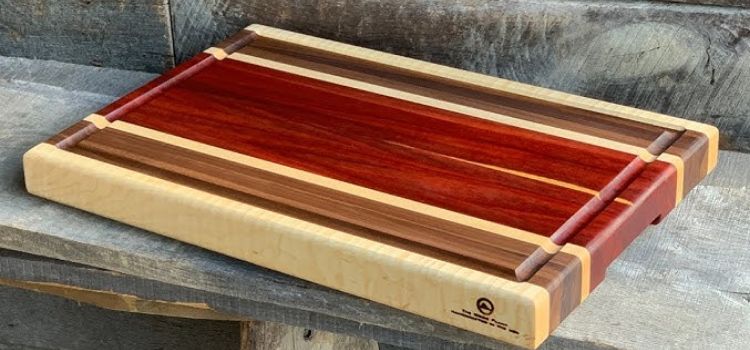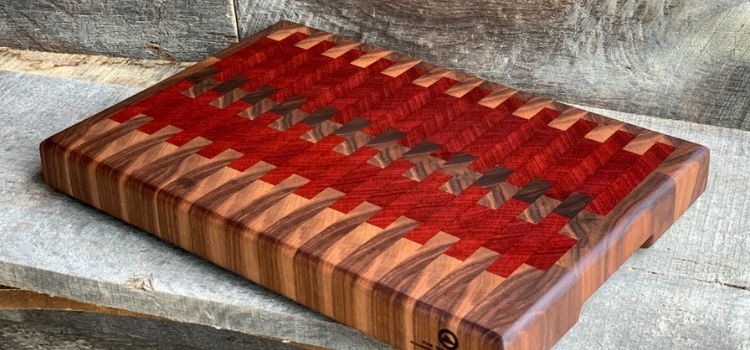As an Amazon Associate, I earn from qualifying purchases

In the realm of kitchen equipment, few items are as essential as the cutting board. It serves as the foundation for meal preparation, safeguarding your countertops and enhancing food safety. Given its importance, selecting the right material for your cutting board is crucial. One material that has garnered attention is padauk wood.
With its striking appearance and unique properties, padauk is considered by many as a viable option for cutting boards. This article aims to explore the suitability of padauk wood for cutting boards, examining its features, benefits, drawbacks, and how it compares to other popular materials.
Properties of Padauk Wood
Padauk wood is celebrated for its distinctive reddish-orange color, which can bring a vibrant touch to any kitchen. Over time, this vivid hue may darken to a rich brown, adding to its charm. Beyond its eye-catching appearance, padauk is known for its hardness and density, which contribute to its robustness as a cutting board material. On the Janka hardness scale, padauk ranks higher than many common woods, making it resistant to everyday wear and tear.
The fine grain structure of padauk not only enhances its visual appeal but also contributes to its durability. This wood is naturally resistant to decay and insects, a feature that makes it particularly appealing for kitchen use where hygiene is paramount. Its stability means it is less prone to warping, a common issue with many other wooden boards.
Benefits of Padauk Wood for Cutting Boards
- Durability: Padauk wood is exceptionally durable due to its hardness, allowing it to withstand rigorous chopping and slicing. This makes it perfect for both avid home cooks and professional chefs, ensuring longevity and value for money as it endures heavy use without significant damage.
- Aesthetic Appeal: The vibrant color of padauk wood adds a striking focal point to your kitchen, enhancing both modern and rustic designs. Its unique appearance not only sets it apart from traditional wood choices but also provides a conversation starter in addition to its functional use.
- Stability: Padauk is resistant to warping and splitting, which helps it maintain its functional integrity over time. This resistance is crucial in kitchens where humidity levels can fluctuate, ensuring reliability for a tool that is used regularly.
Drawbacks of Padauk Wood for Cutting Boards
- Color Migration: Padauk wood can experience color migration, where the rich pigments may bleed into foods or surfaces, especially when the wood is new. Although this issue tends to diminish over time, it’s an important consideration for those using padauk boards for food presentation.
- Maintenance: Like all wooden cutting boards, padauk requires regular oiling to maintain its moisture balance and prevent drying out. While this maintenance step isn’t overly burdensome, it is essential to preserve both the appearance and functionality of the board.
- Cost: Padauk is generally more expensive than other common cutting board materials. Its unique properties and aesthetic contribute to this higher price point, which may not fit every budget, especially for those needing multiple boards.
Comparisons with Other Types of Wood

When selecting a cutting board, comparing padauk with other popular woods can provide valuable insights:
- Maple: Maple is a classic choice known for its light color and moderate hardness. While it is more affordable than padauk, it lacks the unique color and grain pattern. Maple boards generally require less maintenance, making them a practical option for busy kitchens.
- Bamboo: As a sustainable and eco-friendly choice, bamboo appeals to environmentally conscious consumers. It is harder than padauk, which can be rough on knives but is typically less expensive. Bamboo does not offer the same aesthetic as padauk’s rich color but provides a sleek, modern look.
- Walnut: Known for its deep, warm tones, walnut offers a luxurious appearance. It is softer than padauk and may show wear more quickly, but its beauty often justifies the maintenance required. Walnut and padauk share similar price ranges, making them both premium options.
Care and Maintenance Tips
To ensure the longevity and appearance of a padauk cutting board, proper care and maintenance are essential:
- Cleaning: After each use, wash the board with mild soap and warm water. Avoid soaking or using a dishwasher, as excessive moisture can damage the wood. Immediately dry the board with a towel to prevent water absorption.
- Oiling: Regular oiling is crucial to maintain padauk’s vibrant color and prevent the wood from drying. Use a food-grade mineral oil, applying it evenly across the surface. Allow it to soak in for several hours or overnight, then wipe away any excess. Repeat this process every few weeks or when the board appears dry.
- Storage: Store the cutting board in a cool, dry place away from direct sunlight and heat sources. If possible, keep the board upright to allow air circulation, which helps prevent warping and color fading.
Conclusion
In conclusion, padauk wood offers a compelling option for cutting boards with its combination of durability, aesthetics, and stability. While it does require regular maintenance and comes at a higher cost, its unique appearance and robust performance make it a worthwhile investment for many kitchens.
When selecting a cutting board, consider your cooking habits, style preferences, and maintenance willingness. A padauk wood cutting board can enhance your culinary experience, offering both functionality and a touch of artistry to your kitchen space.
FAQ
What are the disadvantages of padauk wood?
Padauk wood can be expensive compared to other options and may require regular maintenance to preserve its vibrant color. Its rich pigments can bleed into foods or surfaces. Additionally, it may not suit every budget, especially if multiple boards are needed in a kitchen.
Is padauk sawdust toxic?
Yes, padauk sawdust can be an irritant and potentially toxic if inhaled. It may cause allergic reactions or respiratory issues in some individuals. Always use protective gear like masks and goggles when cutting or sanding padauk wood to minimize exposure to its dust particles.
What wood should not be used for cutting boards?
Softwoods like pine and cedar should be avoided for cutting boards. They are prone to scratches, dents, and moisture absorption, which can harbor bacteria and odors. Their porous nature makes them less durable and potentially unhygienic compared to hardwood options like birch or maple.
Is padauk hard to cut?
Padauk is relatively hard, which can make it somewhat challenging to cut, especially with hand tools. Its density requires sharp blades and proper techniques to achieve clean cuts. However, with the right equipment, cutting padauk can be managed effectively for woodworking projects.
As an Amazon Associate, I earn from qualifying purchases